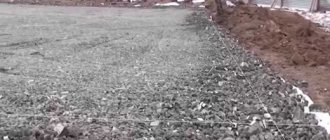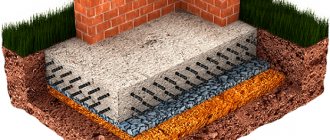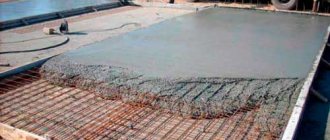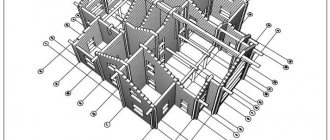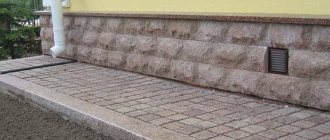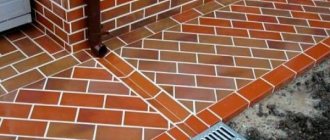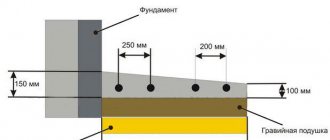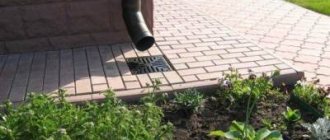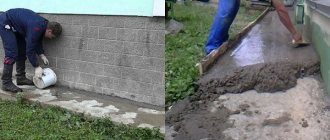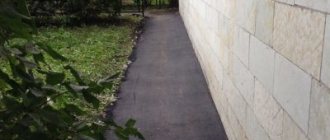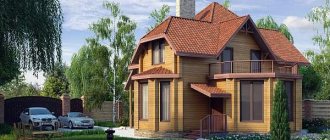Every home owner wants his home to last as long as possible and not need repairs. To do this, you need to do everything possible to prevent damage to the foundation under the influence of various factors. It is necessary to correctly calculate, take into account all the nuances, build the desired structure and drain water from it. In order to drain groundwater, it is worth installing a special drainage system. A high-quality blind area is considered an ideal option for water drainage.
High-quality water drainage
What functions does the blind area perform?
The blind area around the house plays a very important role, so its installation is a prerequisite for preserving the integrity of the foundation and the entire building as a whole.
The design performs many different functions, but the main ones include the following:
- protects the foundation from groundwater;
- increases the thermal insulation value of both the house and the foundation;
- has a long service life;
- crushed stone is considered a durable material that is not afraid of frost, it will not deteriorate over time, so no repairs will be required;
- the structure has a soft structure, which will not lead to damage as a result of soil subsidence;
- the cost of materials and installation is low;
- the work does not take much time, the whole process can be done without the involvement of specialists;
- a large assortment of decorative crushed stone.
The design will reliably protect the house and increase its service life.
The main advantages of a blind area made of crushed stone
The blind area made of crushed stone is easy to manufacture. On average, you need to spend no more than half an hour to equip a square meter of surface. This design is durable, practical, and has a beautiful appearance.
On a note! A blind area made of crushed stone is considered a more optimal and simpler option when compared with structures made of concrete or other materials. It can be done even if there is already drainage around the building.
Advantages and disadvantages
A soft blind area, which can be made independently, has negative and positive sides. The advantages of the material include the following facts:
- Unlike conventional materials, the soft blind area is very resistant to ground movements resulting from thawing or freezing of liquid. So, if the base of the building is located below the freezing point of the soil, it remains in a state of immobility. In this case, the protective structure is located above this level. This means that the joint between the blind area and the base will be damaged in spring and winter, regardless of the quality of its execution. Water will penetrate into the holes that form under any conditions. There can only be one way out of this situation: creating additional insulation from water. If it is not possible to bear such costs, soft structures that are resistant to frost are used;
- a soft blind area can protect the structure of a building, improving its exterior. The top layer is made of various materials, so a blind area made of crushed stone will suit any style of building. Plants, including climbing plants, or lawn grass can be planted on the soft blind area;
- When using crushed stone for a blind area, extruded polystyrene foam and its analogues are used as insulation. This material makes it possible to raise the freezing point of the soil near the blind area. This makes it possible to place the base of the structure at a shallower depth.
If we talk about the disadvantages, we should note the mandatory constant maintenance of the top layer of the blind area. For example, decorative backfill needs to be cleaned regularly, and the lawn needs to be mowed several times a week.
What crushed stone is best to use for the blind area
The main component used for this structure is crushed stone if the blind area is made without concrete.
You can choose a very different size of crushed stone, depending on the preferences of the home owner. Fractions can only affect some of the properties of a material. For example, small crushed stone (up to 2 cm) can be easily compacted. Average crushed stone looks very beautiful, but to make the blind area better, it is best to purchase a combined material that will contain pebbles ranging in size from 0.5 to 4 cm. In addition, this will save money.
If the structure needs to be made around a multi-story building, then it is better to use granite material, which has a higher strength and reliability.
For a private home, gravel is a good option. It can be used not only as a coating, but also as a filler. Of course, the strength is not high enough, but the cost is significantly lower than the above options.
Variety of options
Crushed stone pavement is an excellent choice if groundwater is close to the surface of the earth and can flood the area on which the building is erected.
In this case, crushed stone, if necessary, can be replaced not only with gravel, but also with pebbles or expanded clay. The crushed stone fraction will be 8-32 mm in this case. In most cases, it is customary to use fractions of mixed type.
Faction: what is it?
Crushed stone is small pebbles that are made by crushing various rocks. All of them have an irregular shape and may have different fractions, which are obtained as a result of sifting the material.
In construction, a fraction means a part of a material (it can be loose or in pieces) that has common characteristics. This could be size, density, hardness index, etc.
If we are talking about the fraction of crushed stone, then we are talking about the size and shape. The lower the fraction, the smaller the pebbles will be. Its cost is much higher than that of coarse crushed stone, since processing takes longer.
Types of crushed stone fractions
There are two types of crushed stone fractions that can be used to create a blind area.
- Small – the size of the pebbles does not exceed 20 mm;
- Average – 20-40 mm.
Even smaller material is used for sprinkling paths (size up to 5 mm), and fairly large material (more than 40 mm) is used for the construction of large structures.
Main factions
A blind area made of fine gravel compacts very well, but a medium gravel surface will look more beautiful and will be more comfortable to walk on.
What is the best fraction of crushed stone to choose for the construction of a blind area?
When a home owner chooses which crushed stone is best for him, there are several important points to consider.
Mixed material has a lower cost and is considered practical to use. It allows you to get high-quality drainage.
Mixed type
Also, when choosing, it is worth considering which building the blind area will be built around. For small one-story buildings you can use crushed gravel, and for large multi-story buildings you can use gravel material that can withstand heavy loads.
Installation from paving slabs or asphalt
The construction of paving slabs has its own characteristics. The width of the blind area should be calculated based on the size of the slabs. The best option would be a blind area with a width equal to the width of one or two paving slabs. In this case, you will not have to do additional work in the form of cutting slabs for laying. The main advantage of this type of coating is that when repairing the surface, it is possible to replace each slab separately. With proper use, this design can last a long time.
Scheme of the blind area and plinth.
There is also the possibility of installing an asphalt blind area. In this case, a layer of asphalt of approximately 30 mm is laid on crushed stone, after which it is leveled. This type is usually built around the perimeter of non-residential buildings, since asphalt is not considered an environmentally friendly material and, when heated, substances harmful to human health are released from it. The undoubted advantage of asphalt pavement is that this material resists moisture well. Although in terms of other indicators, including ease of manufacture, a concrete blind area still looks like a more preferable option. Although the answer to the question of which device method to choose depends, among other things, on the cost of materials.
To carry out the specified construction work, the following materials and tools may be needed:
- shovels, crowbar, garden wheelbarrow;
- geotextiles;
- sand, crushed stone of fractions 5-20 or 20-40 mm;
- concrete mix, paving slabs or other covering;
- wooden boards for making formwork, hammers, saws, fasteners;
- decorative border;
- bitumen or sealant for filling expansion joints, etc.
DIY crushed stone blind area
Installation of the structure is divided into several important stages, the sequence of which should be followed:
- planning the blind area, marking boundaries on the site;
- earthworks;
- directly arrangement of the blind area.
We build it with our own hands
A high-quality gravel blind area can be made independently, or its installation can be ordered from specialists from a construction company.
Calculations
The width will be affected by the type of soil and the length of the roof overhang. For normal soils, a width of 60 cm is sufficient, for subsidence soils – 1 m.
The structure must extend beyond the overhang of the roof of the house by at least 20 cm. It is better to increase this distance to make the coating more reliable.
The minimum slope of the blind area from the house can be 0.03 - 3 cm per 1 cm. The best slope indicator is considered to be within 5-10 cm per 1 cm.
Marking
In order to accurately determine the present value of the roof overhang, it is worth using a long plumb line. It is applied with the end to the edge of the roof. The distance that will be marked on the ground is called the projection of the roof overhang.
Marking
Next, measure the distance from the wall of the building to the place marked on the ground. 30 cm is added to the resulting indicator. The pegs installed in the marking areas must be connected using a tightly stretched string. This will be considered the outer contour of the future structure.
Excavation
In the middle of the resulting contour, the top layer of soil is cut off. A trench is dug along the entire perimeter, the depth of which is 0.45 m. The bottom is leveled using a shovel. The evenness of the bottom in the trench must be checked with a level or building level.
Excavation
Next, you should use a herbicide and treat the trench to prevent weeds from growing in it soon. The soil is then compacted using a vibrating rammer or a regular wooden hand rammer.
Construction of the blind area
The bottom of the trench is covered with a 15-centimeter layer of clay and a slope is formed. The clay is carefully compacted and covered with pre-prepared waterproofing material. You can use PVC, roofing felt, ordinary polyethylene film. The roll of waterproofing material should be rolled out in such a way that there is a slight overlap on the foundation of the house. Then it is secured with slats tightly to the surface of the foundation.
Then the contour is covered with a 15 cm layer of sand (it is better to use coarse material). It is leveled with a rake and thoroughly compacted. Next, a geotextile coating is used to prevent weed germination. This material also allows you to avoid pressing crushed stone into the sand, which will not lead to subsidence of the structure. Crushed stone is poured level with the ground (about 15 cm) and thoroughly compacted. For the blind area of the house it is better to use mixed crushed stone.
Advice from professionals
- To prevent water from damaging the house and foundation, it is not enough to tilt only the upper part of the blind area. The liquid will gradually seep through the gravel and sand, so it is worth laying the waterproofing material also on a slope.
- The structure should fit as tightly as possible to the foundation so that there are no cracks into which water can get in. Frosts can have a negative impact on the condition of the structure. The trapped liquid freezes and can cause the blind area to begin to move away from the foundation.
- All calculations must be carried out correctly, down to the millimeter.
- All materials must be of good quality so that repairs are not required again soon.
If all the work is done correctly, this will provide not only reliable protection for the building, but also an attractive decorative element.
